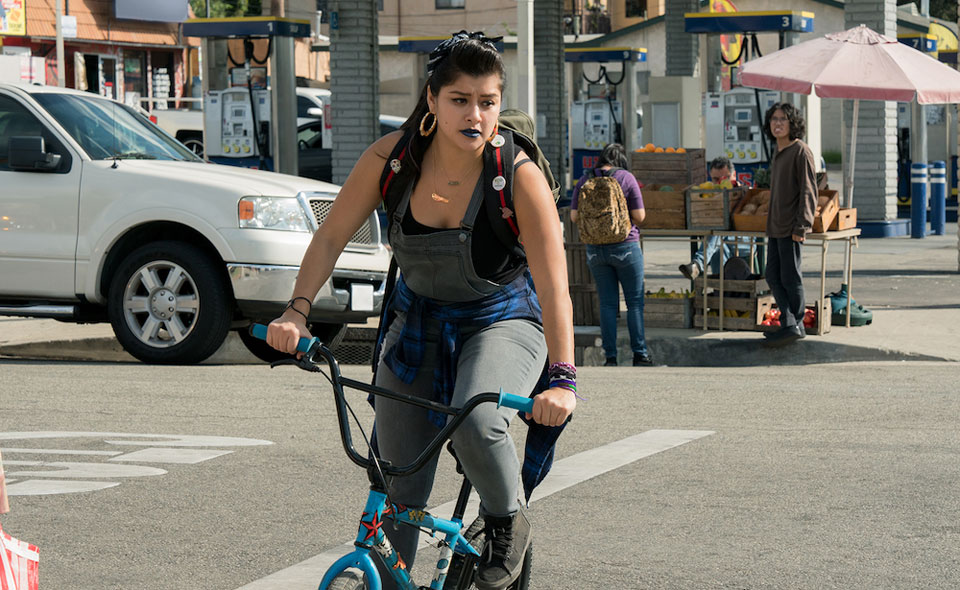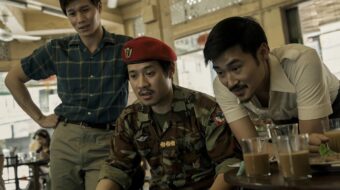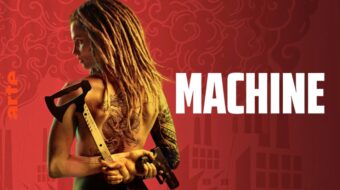
All over the news today is what amounts to articles about a new kind of white flight, again as in the 1960s to the suburbs, but this time which is also a COVID flight from beleaguered cities to the supposed safety of rural areas and the suburbs. There is a different kind of flight, though, which is not voluntary but forced, and that is the decades-long process of gentrification, highlighted as it occurs in a Mexican neighborhood in the first season of the Starz series Vida.
The series, available on Amazon Prime, loses focus in its two subsequent seasons, where it turns into an LGBTQ-themed telenovela, and was canceled after its third, but that is no reason not to celebrate the triumph of season one where Vida tackles the problem of displacement of minority and poor populations better than any of its film and television rivals.
The series opens with a bang as a young Mexican punk goth woman, Marisol or Mari, with a wicked message which she later conveys through spray paint, posts a manifesto declaring her anger and willingness to fight back over the dispossession of her neighborhood, the Boyle Heights section of Los Angeles. Boyle Heights has a long history as a progressive center of the city from its earliest Jewish radical and Japanese populations. It was one of the few neighborhoods in L.A. not to block minorities through what were called restrictive covenants (see: Ronald Reagan et al.).
In 1949 the neighborhood elected the first Mexican and Latino city councilman (and later Congressman), Edward Roybal. Once Jews in the post-war era started moving out to more upscale areas, Roybal acted to further open up the area for what is now its predominantly Mexican population. It is currently the center of an attempt at a land grab by the wealthy dominant class since, with the resettling of more affluent residents in Downtown L.A., it could become a more fashionable adjacent alternative to Downtown’s high rents, something akin to hip and slightly cheaper Brooklyn’s relationship to Manhattan.
Mari’s group, The Vigilantes, are activists disturbed and frightened as they watch the neighborhood change around them. Real estate developers from the nearby Silver Lake area eye the neighborhood, “eager for those Trump dollars.” In the vanguard of this attempted dislocation is a Latino-fronted real estate group “sucking the blood out of the neighborhood.” Against Mari’s and the activist group’s “Make America Brown Again,” the Latino real estate agent Nelson Herrera is buying block after block of what the agency calls BoHe, the rebranding of Boyle Heights as the new hot-spot location. This land grab utilizes white artists, whose outpost Mari spray-paints, as their shock troops, while the real estate agency offers predatory loans that will result in residents losing their local businesses.

Returning to this neighborhood in turmoil are the two Hernandez sisters Emma and Lyn, brought back at the death of their mother, the Vida (“life” in Spanish) of the title, and now proud possessors of their mother’s debt-ridden bar that is a mainstay and casual gay center of the area. Emma is a tough-as-nails, corporate businesswoman back from Chicago, and Lyn, with hippie tendencies, is a kind of palimpsest of all California counter-cultures, a vegan slacker comfortable in the upscale hipness of nearby Silver Lake.
The sisters are thoroughly assimilated, and as the series opens couldn’t be further from the Mexican roots of the neighborhood. Emma wants immediately to get rid of the low-rent tenants in the bar building, many of them undocumented, searching for a “better” clientele. Lyn, meanwhile, dropped by her Anglo boyfriend just after her mother’s death, seeks solace in the orgiastic complacency of Silver Lake poolside sex.
Both are brought down to earth and humanized by their reacquaintance with the neighborhood. Eddy, the gay wife of their mother, who also lays claim to the bar, finally shames Emma into not becoming an agent of dispossession herself by turning out the building’s tenants. Lyn, meanwhile, while being adopted by the affluent Silver Lake crowd, has second thoughts as she is riding the bus home with a Mexican maid who cleans up the bodily fluids strewn by the privileged pool goers.
There is conflict between the two sisters as well, with Emma the responsible one and Lyn perpetually trying to “find herself.” But the more interesting and season one perpetual conflict is between Emma’s corporate and Lyn’s privileged “alternative” values and the fellow feeling of the neighborhood. What in many shows would be a one-episode pilot, where the sisters finally decide to stay at home and become a part of the neighborhood in adopting the bar, takes the entire season because this is not just a personal conflict but a conflict of values. More pointedly, it’s about the sisters learning to reaccept as a positive value the ways the more communal culture they grew up in challenges what they have learned from the capitalist and colonial culture outside the neighborhood.
Two ways the culture manifests are its language and its food. The characters use a simplified form of Spanglish, that constant mixing of English and Spanish that is the mark of a people whose native tongue is devalued. The show does not translate either these phrases or the words to a multitude of Spanish songs, forcing its Anglo audience to learn the phrases, many of which are street lingo, such as the amount of porquería, or bullcrap, with which this neighborhood in the process of being moved in on has to contend. Elsewhere the contentious Mari and a friend rebond over a chamoyada, a flavored sliced ice drink, and Lyn gets into an argument with an upscale Mexican city councilmember about putting Valentina, a brand of hot sauce, on a taco. Food is a signifier and imprint of childhood cultural heritage in the lives of these people.
Neighborhood dispossession has been a popular theme in film and television recently, including a rival Netflix series, also set in Boyle Heights, Gentefied, much slicker and hipper than this series and much less effective. Robert Moses’s mass dispossession of New York’s African-American and Hispanic populations is the subject that underlies the film Motherless Brooklyn, whose heart is in the right place but which is ultimately done in by its clumsy, play-by-the numbers, Chinatown clone narrative. The nearest rival to Vida is The Last Black Man in San Francisco, a thoughtful, quietly sad film about the cleansing of that city of its poor and even lower middle class by the ever increasing rents because of its adjacency to Silicon Valley. But that film is perhaps too quiet and mournful and so does not have the immediate visceral, that is, in-your-face, impact of Vida.

The second and third seasons lose focus, make some calculated mistakes, and pit rival groups against each other in what amounts to the same struggle. Emma’s decision to cut Eddy, the conscience of the tavern, off from her stake in the bar in season two is supposedly, but not actually, rectified by Eddy’s returning to the place, this time as bartender, not co-owner. Emma sells off a mural her mother had commissioned showing the two girls as taking part in the Mexican Revolution. The indescribably sad moment when it is papered over with a beer ad goes unremarked.
Season three features the return of the patriarchy in the form of the sister’s lost father, whose full-force identification with a rigid religiosity threatens their mother’s legacy in making the bar a space of LGBTQ freedom—a space, by the way, that is echoed by the all-LGBTQ writer’s room on this show.
That season also sees Mari leaving The Vigilantes, who themselves get sidetracked and campaign against the transgender bar. Mari turns from collective political work and instead is “discovered” by a website entrepreneur and transformed into a politically trendy “influencer.” Her revolutionary expression of the pain and resistance of her neighborhood is now converted into a more commercial “edginess.”
There is nothing askew with the shift to a more telenovela confrontation with the religious patriarchy. The problem is that the reclaimed father now becomes the primary foe and the gentrification process is sidelined. There is no reason for this. The two are twin aspects of the same oppression and it is needless and heedless to pit one against the other, rather than seeing how they form a seamless whole.
On a positive note, the series does end with the memory of Vida with all her flaws restored in the eyes of her daughters and with a wise neighborhood woman’s santería, that blend of Mexican native traditions with a more primitive Catholicism, posed as an alternative psychic healing method both to the more Western psychoanalysis and to the father’s Pentecostal evangelism.
Starz and sex as pay-per-view commodity
Starz, the network that broadcast Vida in the U.S. is a pay-per-view channel whose rivals, before the streaming services, were HBO and Showtime. Starz, a latecomer to pay-per-view, often attempts to distinguish itself with the quantity of its nudity and sex. The famous opening scene in Preston Sturges’s Sullivan’s Travels recounts a director’s ambitions to make a film of quality about people’s lives during the Depression to which the studio executive keeps interjecting, “But with a little sex?” At Starz, the network execs seem to always be interjecting, for example in the case of Vida’s ambition to tackle the thorny issues of gentrification, “Yes, but with a lot of sex?”
So we get a montage of the two sisters, one lesbian, one straight, copulating as the opening of one show. There are several kinds of “kink,” as in Lyn’s councilman wanting her to wear a strap-on, and Emma, programmatically gay, taking a former male inmate who is working for her for a sexual ride in her office to ease her anxiety. Sometimes this adds to character development—Emma realizes the form of sex she often engages in is simply a corporate brand of using people to satisfy her needs—but just as often it’s simply a way of Starz hooking audiences with a quantity and an outlandishness of nudity that make Game of Thrones look like Camelot.

This has been true in the history of the channel with a show such as Spartacus, nominally about the slave who challenged Rome, distinguishing itself from HBO’s Rome and from other shows on that channel by adding bloodcurdling sadistic violence to the bloodcurdling sadistic sex. Even Outlander, the channel’s most successful entry, is essentially a more sexually explicit, time-traveling kinkily romantic bodice ripper. The ultimate expression of this use of sex as branding mechanism is the channel’s current series P-Valley, which stands for Pussy Valley. (I rest my case.) The show about African-American dancers in a Mississippi strip club does validate their work by presenting it from their point of view, but refuses any wider consideration of how they are trapped within the colonial structure of the backwater of that state.
Starz’s actual glowing moment was Party Down, a two-season series about precarious workers in Hollywood who must labor with a catering company while trying to make dreams that are constantly shattered come true. It’s a hilarious show about the more perpetual downside of the lives of Hollywood hangers on, Mulholland Drive as a sitcom.

Formerly we might have labeled the sex on Starz as “gratuitous,” but that word does not capture the nature of what is going on here. Sex on Starz is corporate and commercial. It is commodified, often not about freedom of bodily expression, but a marketing gimmick to suck in audiences. Even the sex on Vida, which does often also enhance character development, is ultimately not so much boundary-breaking and liberating as in a way degrading, not the sex itself, but the fact that it is often used simply as a means of addicting viewers and thus is devalued.
Such is la vida in the ever more intense competition for viewers who in the midst of an economic malaise, state and militia violence and a pandemic can scarcely afford food and medical supplies, much less add pay channels on top of their already exorbitant cable bill.












Comments